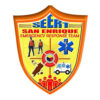
The First Hiligaynon Bible
The Bible was first translated into Hiligaynon in 1898 by Braulio Manikan, a former Catholic priest who went to Spain to study civil engineering, in preparation for his return to the Philippines as a Baptist missionary.
Born on 26 March 1870 in Ibajay town in Aklan, Manikan switched religion after meeting an English Baptist businessman and philanthropist by the name of Armstrong in Barcelona.

Manikan later met Rev. Eric Lund who had just returned to Spain from the United States and was earlier tasked to start a mission in the Philippines because of his mastery of Spanish.
Lund, a Swedish Baptist missionary, assisted Manikan in first translating the Gospel of Mark which was later published in large edition by the British and Foreign Bible Society, according to the booklet “Missions in the Philippines (c. 1910)”.
In 1900, Lund and Manikan arrived in Iloilo and began to preach and conduct regular evening worship in a rented house, which was attended by a steadily increasing number of inquirers.
After building a simple bamboo chapel on Castilla Street in Jaro which became the Jaro Evangelical Church, their mission was reinforced with the arrival of Rev. Charles W. Briggs, and later by Rev. G. E. Finlay.
To produce more Hiligaynon Bibles, Lund and Manikan acquired a small printing press in 1901 which later expanded when a certain Mr. E. R. McIntyre was named manager of the mission press.
“A first edition of the New Testament of 3,000 copies, with 17,000 copies of the gospels bound separately, was all sold out within a year of the time it was issued from the press,” the booklet said.
The second and revised edition later was issued with the first printing of 12,000 copies, and with 103,000 copies of the gospels and The Acts bound in small separate volumes, selling at a cent and a half a piece, it added.
The printing press also produced tracts, Scripture portions, Bible lessons, leaflets on topics of interest and of value to the work, and regular periodicals in Hiligaynon, and later in Cebuano.
By 1905, 1.7 million pages of such literature were printed and distributed at a total cost of but $500.
The printing press also published a monthly religious paper in Hiligaynon “Ang Manugbantala sang Kamatuoran (The Herald of Truth)” and a monthly paper in English “The Pearl of the Orient”.
“The printed page has been a powerful factor in liberalizing the entire Visayan-speaking people, and in spreading the knowledge of the truth,” the booklet noted.
Meanwhile, the first Hiligaynon Bible for use by the Roman Catholic Church was published in 1912, according to the book “The Oxford Companion to the Bible” by Bruce M. Metzger and Michael David Coogan (1993).
But it was not until 1996 when the first Vatican-approved Hiligaynon Bible was published, translated with the help of Irish Columban priest Niall O’Brien who spent years in Negros Occidental, noted the International Bible Society.
Source: Mr. Nereo Lujan











